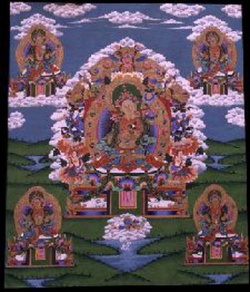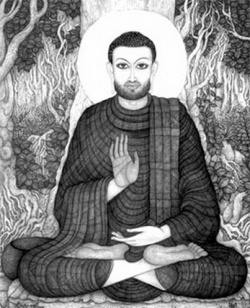Schopenhauer and Buddhism By Peter Abelson
- See also :
- See also :
Schopenhauer and Buddhism
By Peter Abelson
Philosophy East and West
Volume 43, Numer 2
April 1993
P.255-278
(C) by University of Hawaii Press
- If I were to take the results of my philosophy as the standard of truth, I would have to consider Buddhism the finest of all religion.
I. Introduction
When the tenets of Buddhism became known in Europe during the third and fourth decade of the nineteenth century, Arthur Schopenhauer was delighted with the affinity they showed to his own philosophy. Having completed his main work Die Welt als Wille und Vorstellung as early as 1818, he considered it an entirely new (and thus pure) expression of the wisdom once taught by the Buddha--at times he even called himself a "Buddhaist,"
This conviction of being an original European Buddhist kept Schopenhauer from making a detailed philosophical comparison between his system and those of the Buddhist schools he had read up on. to him, the connection was obvious. In reprints of the main work and later writings, he did point out certain similarities, making comments on Buddhism that astonish the present-day reader with their adequacy (considering the immaturity of Indology in his time), but he never bothered to explain the exact philosophical nature of the link he put forward, causing it to remain a matter of atmosphere rather than content.
As a matter of fact, it can be disputed if Schopenhauer's philosophy and Buddhism do indeed breathe the same atmosphere. Schopenhauer often put emphasis on Buddhism's pessimistic outlook on earthly existence, but compared to his world view, which is very severe, Buddhism seems almost cheerful. The Sanskrit word duhkha, by which existence is typified in the first of the Buddha's Four Noble Truths, is usually translated as 'suffering', but it also has the connotation of 'unrest'. In fact, the first Truth is about the transitoriness of life, and how this deprives man of inner peace. To be sure, this is not opposed to anything Schopenhauer said, but it lacks the sheer disgust of life that is characteristic of his doctrine. Yet again. it may be unfair to compare the mood of one man's philosophy with the blended mood of Buddhist literature, with its countless authors. There will undoubtedly be Buddhist texts in which life is depicted in a Schopenhauerian or even more horrifying way. Still, this all goes to show that atmosphere, however crucial to any philosophy of life, should not be too big a factor in comparing two doctrines.
Both Schopenhauerian and Buddhist philosophy express a certain Weltanschauung; therefore cerebral analysis alone will not reveal the real meaning of either--a fair amount of hermeneutical proficiency is also required. But this does not alter the fact that both lines of thought should be compared as specifically as possible if philosophical connections or differences are to be established.
For one thing, the comparativist should be dealing with more than Buddhism as such, since there exists a variety of philosophical views within this religion. It is not even enough when a distinction is made between Hinayana and Mahayana Buddhism, because the history of the latter contains such diverging schools of thought as the Madhyamika and the Yogacara, both of which had a long and irregular development out of their common root, Prajnaparamita literature. Any worthwhile comparison must involve these four basic forms of Buddhist philosophy in their own right.
At the same time, the comparativist should only be concerned with the substantial features of these philosophies (there is no point, for instance, in mentioning details like the shared love of animals in Buddhist and Schopenhauerian philosophy).
All of this considered, I take as a set of criteria for my own comparison the following account of the essentials of Schopenhauer's philosophy.
- 1. It is based on a critique of the intellect, from which it follows that time, space, and causality (the tripartite framework of the world of subjects and objects) are not real in an absolute sense.
- 2. This leads to the assumption of a transcendental reality (automatically making this a religious world view but, because of the ultimate unreality of any subject, and so, too, the unreality of a divine subject, not a theistic one).
- 3. This ultimate reality is by its nature incomprehensible to the intellect, yet is supposed to be 'sensible' in our experience of life (in other words: a reality transcending thought but immanent in life itself).
- 4. This 'recognition' of ultimate reality is related to the fact that life is inescapably ruled by passion, need, pain, and fear, all being promptings of the will, which therefore symbolizes the Real.
I will elaborate on these points as I use them in the following paragraphs.
II. Schopenhauer and the Old Wisdom School
"Old Wisdom School" is a collective name for the first group of sects to evolve out of early Buddhism. The most prominent of these, the Sarvastivada, fixed its philosophical attention on the Buddha's teaching that the five skandhas, or 'transitory factors of worldly existence', namely, material form (rupa), feeling (vedana), perception (samjna), impulses (samskaara), and awareness (vijnaana) were not the self. Whereas the Buddha left it undiscussed whether a self exists at all (obviously regarding the question as pointless), the Sarvastivadins radicalized his teaching into a doctrine that flatly denies all substance. All that we experience in the world and in our minds is restless change; therefore, the idea that things have an imperishable essence 'behind' their ever-changing qualities (like the atman of Hinduism) is untenable. But if there is no lasting self, then every change must involve total destruction. Everything comes into being as it wholly is, to vanish completely after an infinitesimally short moment. After this, something comes about that may look the same but is entirely new.
In this doctrine, the skandhas are interpreted as five groups of dharmas, discrete existence-points constituting the internal and external world. Material things, feelings, thoughts, perceptions. and impulses are nothing but swarms of dharmas, which, because they arise each time in more or less the same configuration, create the illusion of things that last while they change--and of a persistent 'I' beholding these changes and thus being tormented by transitoriness.
Salvation comes when ascesis and meditation bring about the ego dissolving realization that reality is but a turbulence of dharmas.
In arguing that Buddhism could not have been influential on the writing of his main work, Schopenhauer stressed that, if anything, only the Burmese form was known at that time. From this, one gathers that he considered this form the least interesting.
Burmese Buddhism accords with the Old Wisdom School.
It is indeed hard to imagine that he could have found anything in his line in the doctrine above. Because of the rigorous empiricism that it basically is, the reality of time and space, for the dharmas to come about in, is a necessary presupposition. This goes directly against criterion , referring to the epistemological basis of Schopenhauer's philosophy--which I will now summarize in my own words.
"Die Welt ist meine Vorstellung" read the opening words of the main work. Something can only be said to exist if it is in some way perceptible; to exist is to be an object to a subject. And since I am the only subject the existence of which I cannot doubt, the world is my representation (in using this term in stead of 'perception' Schopenhauer wanted to stress the activeness of the subject).
At the same time, however, there is no subject without object. 'Subject' and 'object' are correlative concepts, deriving their meaning from each other; therefore, the one cannot be more real than the other. If the not-I is a mere representation, something to which no absolute reality can be attributed, this also goes for the I. Therefore, the world as representation embraces both the things that I behold and myself as their beholder. Or, in Schopenhauer's words: the opposition of subject and object is the "first, general and essential form" of the Vorstellung.
Who or what, then, is the true representer of this world in which I am an individual being? To find an answer, we must take a closer look at how the world is known.
Just how is the world in which I am an individual subject of objects represented?--as a spatiotemporal universe, ruled by the fourfold Law of Sufficient Reason (Satz vom zureichenden Grunde). Whatever I perceive is in space and time, and for anything to exist or happen there must be either a physical, logical, mathematical, or motivational reason. My entire experience of the world, from discursive ideas down to basic perceptions, is based on these a prior conditions. Even the notion of being a physical entity is basically no more than the immediate assumption that vision, sound, touch, smell, and taste are the temporal effects that an outside world has on 'my body'.
Thus, for anything to be empirically real, it must be spatial, temporal, and causal. Yet space, time, and causality cannot be proven to be empirically real themselves! If space is thought of as an empirical entity, the insoluble problem arises whether it is finite or infinite. In the first case, there would have to be something 'outside' space, a meta space, which is an absurd notion; but in the second case it could never be differentiated of anything and would therefore have no identity. If time is finite, there would have to be something 'before' and 'after' it, which again is absurd; but if it is infinite, it would take an eternity to arrive at the present moment, which therefore could never come about. Finite causality would enhance an unimaginable 'first cause' of all events in the universe, while infinite causality poses, mutatis mutandis, the same problem as infinite time.
This antinomic character of time, space, and causality shows them to be not 'things' but the very cadres of our sensory and intellectual experience of the world. They are not experienced themselves, but the tripartite way in which we experience. Schopenhauer adheres to Immanuel Kant's maxim: empirical reality is transcendental ideality: as long as we consider ourselves personal beings (and we cannot do otherwise without going mad), we must take the empirical world to be quite real. But ultimately this causal universe in space and time must be seen as ideal, of intellectual origin.
Ultimate reality, or the Ding an sich as Schopenhauer calls it in tribute to Kant, must be transcendent to space, time, and causality--a transcendent One--having the world, including my person, as its representation.
True, the epistemology above shows the 'I' to be a mere representation, but it leads up to a monastic conclusion with which the utter pluralism of the Old Wisdom School is totally incompatible.
III. Schopenhauer and the Prajnaparamita
The Mahayana (Great Vehicle) first started as a counter movement to the Old Wisdom School, calling it Hinayana (Small Vehicle) because of its elitist character. Maintaining the doctrine of no-self only as a theory of empirical phenomena, the reformists produced a vast body of sutras, the prajnaparamita ('Wisdom Gone Beyond'), which were claimed to hold the true exegesis of the Buddha's teachings.
Although most nineteenth-century Orientalists shunned Prajnaparamita literature because of its mysteriousness, Schopenhauer, a thinker of notorious independence, equated it to the gist of his doctrine.
Whatever remains after the Will has vanished must seem to those who are still filled by it nothing. But to the man in whom the Will has turned and negated itself, this world, so real to us with all its suns and Milky Ways, is--nothing.
In the third edition, a footnote is added to these concluding words of Die Welt als Wille und vorstellung:
- This is precisely the "Pradschna-Paramita" of the Buddhists, the "Beyond All Knowledge', i.e., the point where subject and object no longer exist. (See I. J. Schmidt, Ueber das Mahayana und Pratschna-Paramita.)
The exact words of Isaak Jacob Schmidt are no longer ascertainable, but these suutras indeed reflect the insight that the world of subject and object is but a restless shadow play of true reality. Still, this alone is no proof of a specific relation (after all, the unreality of subject and object has been held by others, such as Hegel; and "Hegelei" was the very last thing Schopenhauer felt close to).
I will now comment on some characteristic excerpts of the Prajnaparamita, with regard to the criteria mentioned in section I above.
- (A) The Lord: One who perceives form (feeling, perception, impulse. or consciousness), has duality. One who perceives anything has duality. As far as there is duality, there is existence. Insofar as there is existence, there are the karma-formations. And as far as there are karma-formations, beings are not liberated from birth, decay, sickness, death, from sorrow, lamentation, pain, sadness and despair.
This summary of the consequences of our 'skandha fallacy' clearly shows the idea that earthly existence is based on the mutuality (duality) of subject and object.
Whereas Schopenhauer's world as Representation is governed by the Satz vom Grunde, the world according to the Buddhists is also causal to the core, insofar as it is karmic: no action or occurrence is without cause, or without effect on future actions and occurrences.
Schopenhauer made several remarks on the belief in reincarnation, which is quintessential for the karma doctrine. He assumed there had to be some truth in a belief as widespread as this, but he could not accept the idea of metempsychosis: the transmigration of a soul with personal hallmarks. He argued that one's personality, consisting mainly of opinions and memories, was basically intellectual and as such tied to the Vorstellung that is human existence. Thus it could never be carried over the threshold of death. Reincarnation could only be true in the sense of a palingenesis of the Ding an sich into the individual beings of the world as Representation. He was convinced, however, that the Buddhists used the concept of metempsychosis only as a myth for the common herd and, like him, really held the idea of palingenesis of the Absolute, especially since he had read about an "esoteric Buddhist doctrine"--undoubtedly the doctrine of the metaphysical alaya consciousness of the idealist Yogacara school (discussed at length in ¡± 5).
In fact, the matter is more complicated. Surely, knowing that the skandhas are not the self, no learned Buddhist.





